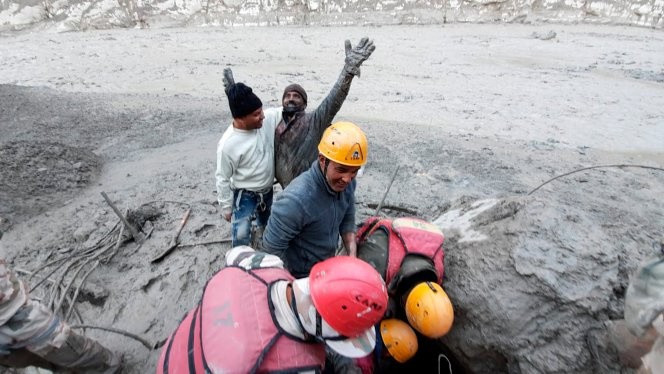Indian rescuers were struggling to reach the victims trapped after part of a glacier in the Himalayas broke off and released a torrent of water and debris slammed into two hydroelectric plants. At least nine people were killed, and 140 were missing.

More than 2,000 members of the military, paramilitary groups, and police took part in the search-and-rescue operation, including soldiers expert in mountaineering, working into the night under bright halogen lights, authorities said.
Video from the northern state of Uttarakhand in India shows the dirty floodwaters rushing into a valley and surging through a dam, smashing it into bits and rushing downstream with no resistance
The flood was caused when a portion of the Nanda Devi glacier snapped off in the morning, releasing water trapped behind it, authorities said. It rushed down the mountain and into other bodies of water, forcing the evacuation of many villages along the banks of the Alaknanda and Dhauliganga rivers.
The Alaknanda hydroelectric plant was destroyed along with the under-construction plant in Dhauliganga. The former crumbled while the latter took several major damages.
According to paramilitary Indo Tibetan Border Police spokesperson Vivek Pandey, at least 42 workers were trapped in two tunnels at the Dhauliganga project. Twelve were rescued from one of the tunnels, while at least 30 others remained stranded inside the other.
"The rescuers used ropes and shovels to reach the mouth of the tunnel. They dug through the debris and entered the tunnel. They are yet to come in touch with the stranded people," said Chief Minister Trivendra Singh Rawat, Uttarakhand's top elected official.
140 workers of the two plants went missing while at least 9 casualties were confirmed.
The Himalayan area has a chain of hydropower projects on several rivers and their tributaries. Rawat said authorities were able to save other power units downstream because timely action is taken to release water by opening gates.
Related Article: Oldest Ice in Earth: The Hidden Glacier Ice in McMurdo Dry Valleys
Casualties and Damages
The floodwaters also damaged houses, said Ravi Bejaria, a government spokesman, though he had no details on the number and whether any of the residents were injured, missing, or dead.
"It all started sometime around 10 in the morning. We heard a bang, which shook our village," Dinesh Negi, a Raini village resident, told The Associated Press by phone. He said they watched from high above one of the rivers as the water turned muddy and surged in a torrent.
According to Negi, they knew something wrong happened when they saw the raging fury of the river.
Global Warming
Scientists have long known that global warming contributes to the melting and the breakup of the world's glaciers.
Anjal Prakash, research director and adjunct professor at the Indian School of Business who has contributed to U.N.-sponsored research on global warming, said that while data on the cause of the disaster was not yet available, "this looks very much like a climate change event as the glaciers are melting due to global warming."
ALSO READ: Arctic's in Danger! 5 Infographics Showing the Alarming State of the Arctic
For more environmental news, don't forget to follow Nature World News!
© 2025 NatureWorldNews.com All rights reserved. Do not reproduce without permission.





